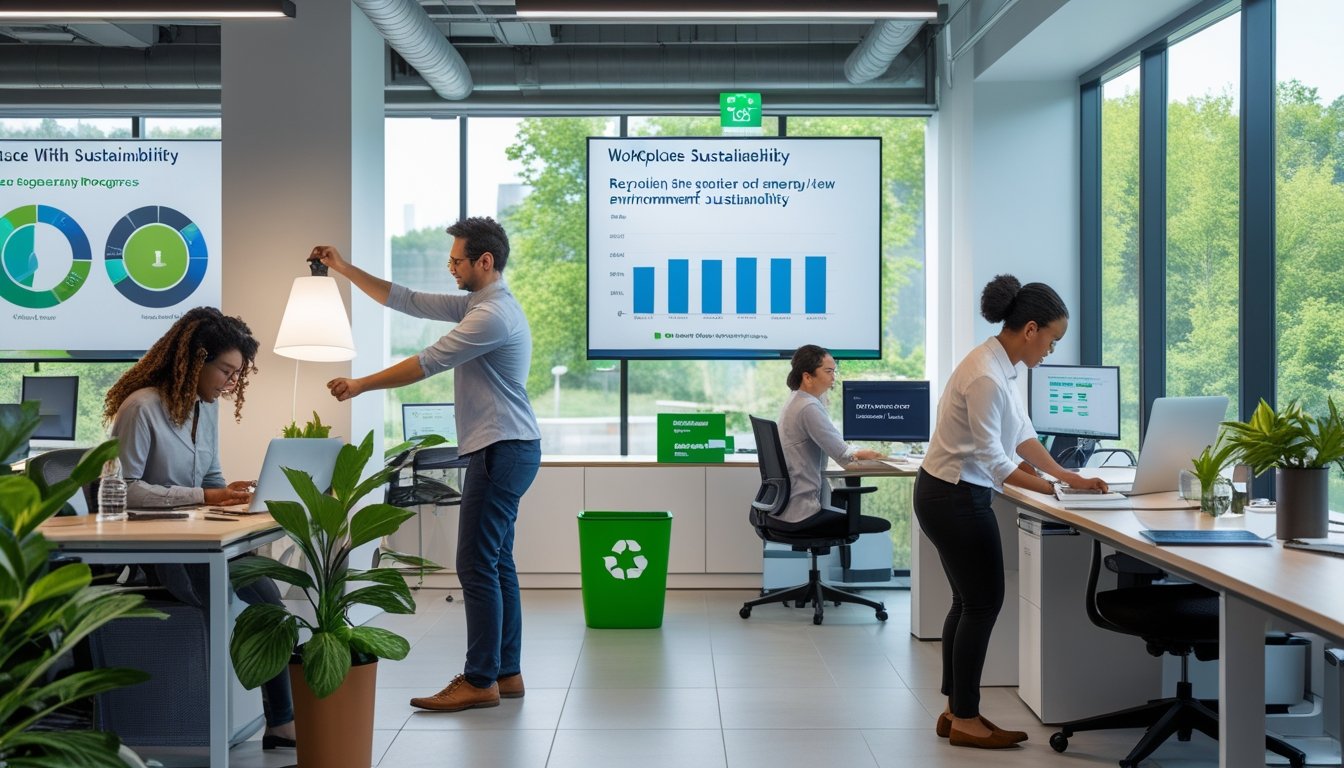Late updated: 24 Aug 2025 13:08
Written by: Amber Collins
How To Increase Workplace Sustainability: Effective Strategies For Implementation
Enhancing workplace sustainability isn't merely an eco-friendly gesture; it's a strategic move that can dramatically benefit a business. By implementing sustainable practices, we not only contribute to preserving our planet but also potentially reduce operational costs and improve company reputation. When employees recognise a genuine commitment to sustainability, it boosts their engagement and attracts potential talent who share similar values.

Reducing paper usage, recycling e-waste diligently, and embracing eco-friendly products are straightforward practices that any workplace can adopt today. As part of our commitment to sustainability, we can also explore energy-efficient options and involve employees in eco-conscious initiatives. Such collective efforts can foster a culture that prioritises environmental responsibility.
Creating a sustainable workplace is not a one-time effort; it's an ongoing journey. Each small change has the potential to create a larger impact when consistently applied. By taking practical actions and continuously striving for improvement, we make strides towards a better future for both our business and the environment.
Key Takeaways
- Embrace practical sustainability strategies for better workplace impact.
- Focus on simple actions like recycling and reducing energy usage.
- Foster an ongoing commitment to environmental responsibility.
Fundamental Strategies to Increase Workplace Sustainability
Achieving workplace sustainability requires targeted strategies across operations, personnel, and organisational goals. By addressing carbon emissions, forming dedicated green teams, and setting measurable objectives, we can create a more sustainable environment.
Reducing Carbon Emissions Through Daily Operations
Reducing carbon emissions is imperative for tackling climate change. One effective strategy is to enhance energy efficiency in our buildings through smart lighting systems and energy-efficient appliances. Switching to renewable energy sources, like solar or wind, can further minimise our carbon footprint.
Transport policies can also be adapted. Encouraging carpooling, using public transit, or offering incentives for cycling can significantly decrease emissions. Digitalisation of documents and processes not only cuts paper waste but also reduces energy consumed during printing and storage.
Establishing Effective Green Teams and Employee Engagement
Green teams play a crucial role in driving sustainability initiatives. These teams, composed of motivated employees, can spearhead environmental programmes and foster a culture of responsibility. Employee engagement is essential for the success of these initiatives.
Training programmes can enhance awareness regarding the importance of sustainability. Workshops on waste reduction or energy conservation techniques provide practical knowledge employees can apply both personally and professionally. Regular updates on progress and achievements help maintain enthusiasm and involvement.
Setting and Tracking Sustainability Goals and ESG Initiatives
Defining clear sustainability goals and tracking progress is vital. Employing frameworks like ESG (Environmental, Social, and Governance) helps us monitor and adapt our strategies. Specific goals might include reducing waste by a certain percentage or sourcing a defined portion of materials sustainably.
We can leverage technology for tracking. Various software solutions enable efficient monitoring and reporting of sustainability metrics. Regular assessments and adjustments ensure that our practices evolve alongside emerging challenges and opportunities in environmental stewardship. This methodical approach fosters accountability and long-term success.
Practical Actions for Enhancing Environmental Impact at Work

Our workplace environments have significant potential for improvement in terms of sustainability. By focusing on energy use, waste management, commuting, and procurement, we can make notable strides toward reducing environmental impact.
Improving Energy Efficiency and Renewable Adoption
Enhancing energy efficiency is a crucial step. Conducting energy audits helps identify energy wastage areas. Switching to LED bulbs and energy-efficient lighting reduces electricity consumption. Motion sensors and smart thermostats provide automation benefits, optimising power use based on occupancy and temperature.
Implementing solar panels can further boost sustainability efforts. These renewable energy solutions not only decrease reliance on non-renewables but also result in long-term cost savings. By adopting these practices, a workplace can significantly minimise its carbon footprint.
Promoting Waste Management and Waste Reduction
Effective waste management is essential for reducing environmental impact. Recycling programmes encourage sorting and processing of waste materials. Implementing a composting program for organic waste further decreases landfill contributions.
Eliminating single-use plastics and promoting reusable water bottles helps with waste reduction. Advocating for double-sided printing also conserves paper resources. These straightforward practices are cost-efficient and foster a culture of mindfulness about waste. Encouraging these behaviours across the organisation can lead to significant waste reduction.
Encouraging Sustainable Commuting and Remote Work
Sustainable commuting methods significantly reduce carbon emissions. Promoting walking to work, carpooling, or using electric vehicles supports sustainable transportation. These initiatives not only cut emissions but also save costs for employees.
Encouraging remote work, telecommuting, and virtual meetings can further enhance sustainability. Video conferencing tools allow for effective collaboration without the need for travel, reducing the workplace’s carbon footprint. Embracing these options offers greater flexibility while also supporting environmental goals.
Fostering Sustainable Procurement and Green Sourcing
Prioritising sustainable procurement is vital for minimising workplace environmental impact. Embracing green sourcing ensures that the products and services we choose align with environmental standards. This involves selecting suppliers who share our commitment to sustainability.
Sustainable sourcing considers both environmental and social factors in the supply chain, promoting ethical practices. By partnering with eco-friendly suppliers, we help in conserving resources and promoting responsible manufacturing. Adopting comprehensive procurement policies can fundamentally reshape our environmental impact.
Frequently Asked Questions

Increasing workplace sustainability involves adopting practices that reduce environmental impact while improving business operations and employee welfare. These FAQs tackle some of the common questions around fostering eco-friendly initiatives and the benefits these can bring to an organisation.
What are effective approaches to fostering environmentally friendly practices in the workplace?
Employing energy-efficient lighting and appliances is a key step. Encouraging digital documentation over paper is another. Setting up recycling stations also contributes to a greener workplace.
In what ways can businesses implement sustainability strategies effectively?
Clear guidelines and training programmes help embed policies across the company. Regular audits to track resource consumption can provide insights for improvement. Collaboration with green-focused vendors enhances these efforts.
How can employee engagement in sustainability activities be enhanced?
Incentive programmes for sustainable practices can boost participation. Workshops and seminars on environmental issues foster awareness and accountability. Creating sustainability committees within the organisation also promotes engagement.
What innovative measures can be taken to promote a 'go green' ethos within the office environment?
Offering commuter benefits for using public transport can reduce carbon footprints. Implementing a plant-rich workspace not only enhances air quality but also creates a more pleasant environment. Providing reusable kitchenware in break rooms helps cut single-use plastics.
Can you suggest some unique and effective ideas for promoting sustainability at work?
Hosting green events, like office-wide clean-ups or tree-planting days, are effective. Establishing a sustainable product swap amongst staff can minimise waste. Encouraging remote work reduces emissions from employee commutes.
What are the key benefits that sustainability brings to a business environment?
Implementing sustainable practices can lead to cost savings through reduced energy use. They can improve the well-being and satisfaction of employees, leading to increased productivity. Additionally, a commitment to sustainability enhances a company’s reputation among clients and stakeholders.
